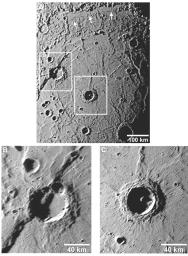
|
A Closer Look into Rembrandt Basin
- Click the image above for a larger view
- Full-Res JPEG (957 x 1303) (207.2 kB)
- Full-Res TIFF (957 x 1303) (1.2 MB)
Caption:
Details about the newly discovered Rembrandt impact basin ( PIA12049 ) were published recently in Science magazine, and the images shown here are from that article. The top image shows a NAC mosaic of the interior of Rembrandt, and white arrows indicate areas near the basin's northern rim that have been infilled by volcanic smooth plains. The white boxes outline areas with two craters that are shown in more detail in the bottom images. The walls and floor of the crater in the bottom left image (diameter of 60 kilometers, 37 miles) have been cross-cut and offset by a younger lobate scarp. In contrast, the crater in the bottom right image (diameter of 44 kilometers, 27 miles) exhibits characteristics of a young, fresh crater that has not been altered by scarps or volcanic smooth plains. By examining details such as these for different features within Rembrandt, the relative timing of volcanism, deformation, and cratering within this basin is being revealed.
Date Acquired:
October 6, 2008
Image Mission Elapsed Time (MET):
131766396
,
131766401
, 131766417
Instrument:
Narrow Angle Camera (NAC) of the Mercury Dual Imaging System (MDIS)
Scale:
Rembrandt basin has a diameter of 715 kilometers (444 miles)
Spacecraft Altitude:
16,800 kilometers (10,400 miles)
Background Info:
These images are from MESSENGER, a NASA Discovery mission to conduct the first orbital study of the innermost planet, Mercury. For information regarding the use of images, see the MESSENGER image use policy .
Cataloging Keywords:
| Name | Value | Additional Values |
|---|---|---|
| Target | Mercury | |
| System | ||
| Target Type | Planet | |
| Mission | MESSENGER | |
| Instrument Host | MESSENGER | |
| Host Type | Orbiter | |
| Instrument | Mercury Dual Imaging System (MDIS) | |
| Detector | Narrow Angle Camera (NAC) | |
| Extra Keywords | Crater, Grayscale, Impact, Volcano | |
| Acquisition Date | ||
| Release Date | 2009-05-26 | |
| Date in Caption | 2008-10-06 | |
| Image Credit | NASA/Johns Hopkins University Applied Physics Laboratory/Carnegie Institution of Washington Figure 2 from Watters et al., Science, 324, 618-621, 2009. | |
| Source | photojournal.jpl.nasa.gov/catalog/PIA12053 | |
| Identifier | PIA12053 | |
